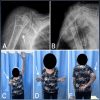Predictive Factors for Poor Prognosis in Non-Surgical Treatment of Proximal Humerus Fractures in Elderly Patients
- PMID: 39449938
- PMCID: PMC11500265
- DOI: 10.7759/cureus.70083
Predictive Factors for Poor Prognosis in Non-Surgical Treatment of Proximal Humerus Fractures in Elderly Patients
Abstract
Introduction: Proximal humerus fractures (PHF) are common in the elderly, accounting for significant morbidity and mortality. Non-surgical treatment is a common option for low-demand elderly patients, but it can lead to unsatisfactory functional outcomes in some cases. The identification of predictive factors for poor prognosis in non-surgical management remains unclear. This study aimed to determine the predictive factors for poor prognosis in elderly patients treated non-surgically for displaced PHF and to assess associated complications.
Methods: A retrospective cohort study was conducted involving patients aged 60 years or older with displaced PHF treated non-surgically from May 2020 to January 2023 at a reference hospital for orthopedic trauma. The primary outcome was functional assessment using the American Shoulder and Elbow Surgeons (ASES) scale at 12 months. Predictive factors such as metaphyseal fracture comminution, Pain Catastrophizing Scale (PCS) scores, and radiographic criteria were analyzed. Multivariate regression analyses were performed to identify independent predictors of poor outcomes.
Results: Out of 140 initially selected patients, 103 met the inclusion criteria and completed the follow-up. The mean ASES score was 71.3±25.4 points. Multivariate analysis identified metaphyseal comminution (p < 0.001) and PCS scores ≥ 30 (p < 0.001) as significant predictors of poorer functional outcomes. Complications were observed in 17.4% of patients, including osteonecrosis (6.7%), nonunion (4.9%), and persistent pain and stiffness (5.8%).
Conclusion: Metaphyseal comminution and high PCS scores are significant predictors of poor prognosis in elderly patients undergoing non-surgical treatment for displaced PHF. These findings highlight the importance of considering both biomechanical and psychological factors when managing proximal humerus fractures in this population. Further studies with larger sample sizes and prospective designs are needed to validate these findings and refine treatment strategies.
Keywords: elderly patients; functional outcomes; non-surgical treatment; predictive factors; proximal humerus fractures.
Copyright © 2024, Beraldo et al.
Conflict of interest statement
Human subjects: Consent was obtained or waived by all participants in this study. Ethics Committee of the Faculdade de Medicina de Jundiaí, São Paulo, Brazil issued approval 6.391.017. The study was registered in Plataforma Brasil (CAAE: 73648623.4.0000.5412). Animal subjects: All authors have confirmed that this study did not involve animal subjects or tissue. Conflicts of interest: In compliance with the ICMJE uniform disclosure form, all authors declare the following: Payment/services info: All authors have declared that no financial support was received from any organization for the submitted work. Financial relationships: All authors have declared that they have no financial relationships at present or within the previous three years with any organizations that might have an interest in the submitted work. Other relationships: All authors have declared that there are no other relationships or activities that could appear to have influenced the submitted work.
Figures



Similar articles
-
Repair of proximal humerus fracture nonunions using a standardized treatment algorithm: a case series.Eur J Orthop Surg Traumatol. 2021 Aug;31(6):1151-1159. doi: 10.1007/s00590-020-02857-2. Epub 2021 Jan 8. Eur J Orthop Surg Traumatol. 2021. PMID: 33417051
-
Reverse Total Shoulder Arthroplasty Demonstrates Better Outcomes Than Angular Stable Plate in the Treatment of Three-part and Four-part Proximal Humerus Fractures in Patients Older Than 70 Years.Clin Orthop Relat Res. 2023 Apr 1;481(4):735-747. doi: 10.1097/CORR.0000000000002480. Epub 2022 Nov 15. Clin Orthop Relat Res. 2023. PMID: 36383078 Free PMC article.
-
What Factors Are Associated With Poor Shoulder Function and Serious Complications After Internal Fixation of Three-part and Four-part Proximal Humerus Fracture-dislocations?Clin Orthop Relat Res. 2022 Aug 1;480(8):1566-1573. doi: 10.1097/CORR.0000000000002190. Epub 2022 Mar 24. Clin Orthop Relat Res. 2022. PMID: 35333197 Free PMC article.
-
[Research progress on valgus impacted proximal humeral fractures].Zhongguo Xiu Fu Chong Jian Wai Ke Za Zhi. 2024 Jan 15;38(1):107-112. doi: 10.7507/1002-1892.202308062. Zhongguo Xiu Fu Chong Jian Wai Ke Za Zhi. 2024. PMID: 38225849 Free PMC article. Review. Chinese.
-
Outcome measures reported for the management of proximal humeral fractures: a systematic review.J Shoulder Elbow Surg. 2020 Oct;29(10):2175-2184. doi: 10.1016/j.jse.2020.04.006. Epub 2020 Jun 9. J Shoulder Elbow Surg. 2020. PMID: 32951643
References
-
- Epidemiology of proximal humeral fractures: a detailed survey of 711 patients in a metropolitan area. Passaretti D, Candela V, Sessa P, Gumina S. https://doi.org/10.1016/j.jse.2017.05.029. J Shoulder Elbow Surg. 2017;26:2117–2124. - PubMed
-
- Mortality after osteoporotic fractures. Johnell O, Kanis JA, Odén A, et al. Osteoporos Int. 2004;15:38–42. - PubMed
-
- Interventions for treating proximal humeral fractures in adults. Handoll HH, Elliott J, Thillemann TM, Aluko P, Brorson S. https://doi.org/10.1002/14651858. CD000434.pub5. Cochrane Database Syst Rev. 2022;6:0. - PMC - PubMed
-
- Surgical vs nonsurgical treatment of adults with displaced fractures of the proximal humerus: the PROFHER randomized clinical trial. Rangan A, Handoll H, Brealey S, et al. https://doi.org/10.1001/jama.2015.1629. JAMA. 2015;313:1037–1047. - PubMed
LinkOut - more resources
Full Text Sources
Miscellaneous
